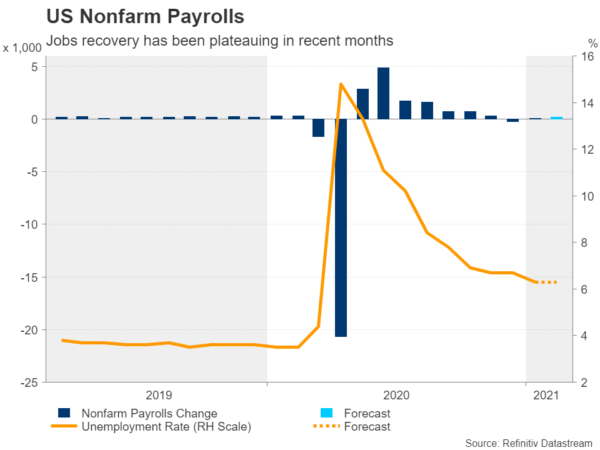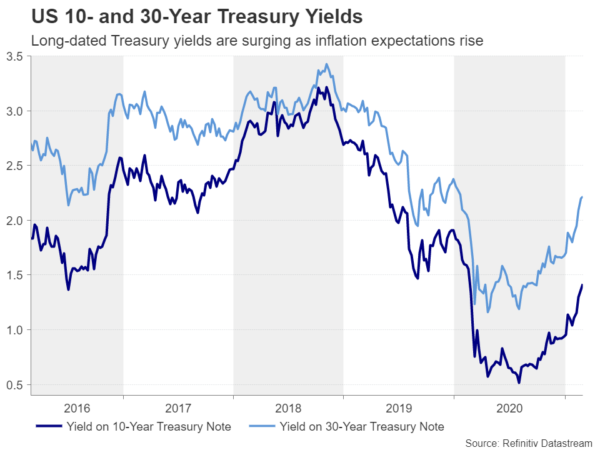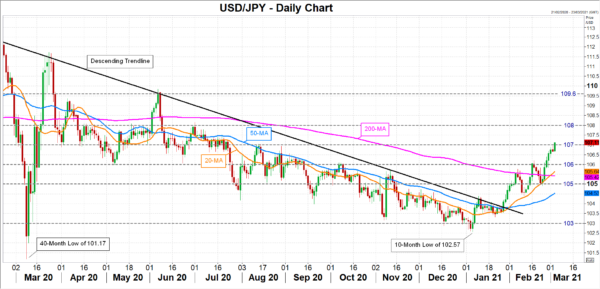After a sluggish couple of months, America’s labour market is expected to have regained some momentum in February. The latest nonfarm payrolls report will probably reveal a healthy pickup in jobs growth when released on Friday at 13:30 GMT. However, following the recent rout in the bond market, an upbeat set of numbers run the risk of refuelling the rally in Treasury yields, pushing the dollar higher and piling pressure on the Federal Reserve to step in.
A patchy rebound
The speed of the jobs recovery from the depths of the Covid crisis initially confounded expectations, taking policymakers by surprise. However, the rebound slowed markedly at the end of 2020 even as other sectors of the economy continued to enjoy robust growth. This divergence highlights the fact that the stay-at-home companies are not very labour intensive, and with many parts of the economy still shut or operating at reduced capacity, the stall in the recovery should not have come as too much of a surprise.
But now that the stimulus cash from Congress is flowing to the American people again and virus cases are on the decline, hiring likely picked up some pace in February. The latest analyst forecasts predict the US economy added 180k jobs in February, up from a meagre 49k in January. The unemployment rate is expected to have stayed unchanged at 6.3% as more people probably re-joined the workforce.
The forecasts for wage growth are also upbeat, with average earnings projected to have risen by 5.3% year-on-year, almost keeping up with the prior months’ 5.4% rate, which was an 8-month high.
Markets might like weak jobs data
If the February numbers underwhelm again, investors are unlikely to panic. In fact, another soft jobs report is probably the best outcome for the markets as it would reinforce the Fed’s cautious stance amid a selloff in government bonds on the back of the reflation trade. A ‘Goldilocks recovery’ where there’s no risk of a double-dip recession and yet growth isn’t running so hot as to force the Fed to consider putting its feet on the accelerator is just what stocks and other risk assets need to keep the bull market going.
Even a shockingly dire report would not significantly alter the outlook as Congress looks set to soon approve the next round of stimulus, which should provide a more than enough boost to keep the recovery going until vaccinations achieve herd immunity and shuttered businesses can reopen.
Fed’s silence grows louder; Powell speech eyed
The bigger question is what would happen if employment were to bounce back very strongly and spark another jump in Treasury yields. Would the Fed continue to turn a blind eye or would it signal it may have to shift some of its asset purchases towards longer-dated bonds? Doing nothing risks encouraging an unwelcome tightening in financial conditions, which would almost certainly hurt equities, whilst attempting to keep yields depressed could further stoke fears of higher inflation as well as a stock market bubble.
All this will put the spotlight firmly on the Fed chief, Jerome Powell, on Thursday when he speaks at a Wall Street Journal event at 17:05 GMT.
Dollar increasingly bullish versus the yen
What Powell says could dictate the scale of the market moves from the NFP data on Friday. The US dollar could come under heavy selling pressure against the likes of the euro, pound and Australian dollar if Powell uses tougher language on the dangers from rising yields. However, given the overall optimistic outlook for the US economy, the dollar could suffer only mild losses against safe havens such as the yen. The Bank of Japan’s yield curve control policy is likely to keep the yen on the backfoot even if Treasury yields were to retreat either from Fed intervention or poor jobs figures.
Hence, dollar/yen is on course to surpass the 107 mark, with the 108 level being the next target for buyers. Above that, focus would turn to the 109.60 region where prices peaked in June 2020.
To the downside, the 106 level is the nearest major support followed by the 20-day moving average (MA), currently at 105.64. As long as the pair is able to hold above the 20-day MA, there is no risk to the near-term bullish outlook.
















